Michael W. Balfe, the ‘Irish Italian’
Published in 18th–19th - Century History, Features, Issue 1 (Spring 2003), Volume 11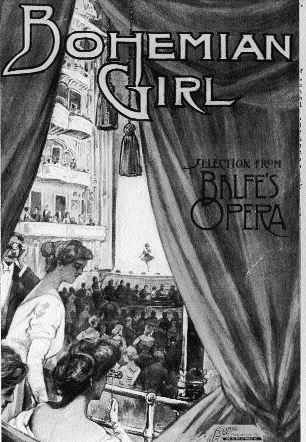
Sheet music cover (c. 1920) for Balfe’s best-known opera, The Bohemian Girl.
When Michael William Balfe returned to Dublin in November 1838 it was his first visit to his native city since his departure in 1823 at the age of fifteen. The years spent abroad had brought great fame and success to the young Dubliner.
Early career
Balfe was born on 15 May 1808 at 10 Pitt Street, Dublin (renamed Balfe Street by Dublin Corporation in 1917). His father, William Balfe (1783?–1823), offered dancing classes in Dublin and Wexford, where his son was first exposed to music. Young Balfe’s musical talents became apparent at an early age, and his father placed him under the tutelage of various teachers. Balfe’s mother, Mary Ryan, was related to Leonard McNally, successful lawyer, opera librettist, and informer on the United Irishmen. The child prodigy gave his first public performance as a violinist at the Rotunda concert rooms in Dublin in May 1817 when he was only nine years old. According to newspaper reports the child astounded the audience with his amazing execution and musical skills. As he progressed, his interests turned to composition. Isaac Willis of Westmoreland Street, Dublin, published his first song, ‘The Lover’s Mistake’, in 1822.
With the death of Balfe’s father at the age of 40, in January 1823, the young student moved to London to further his career and to help support his mother and two sisters, making his debut there as a violinist later the same year. He joined the orchestra at Drury Lane Theatre under the direction of a fellow Dubliner, the multi-talented Tom Cooke (1782–1848). Apparently gaining a sponsor in London, in 1825 the young musician, encouraged by his friends, moved to Italy, where he studied musical composition under the composer Ferdinando Paer (1771–1839) in Rome, and harmony and counterpoint under Vincenzo Federici (1764–1827) in Milan.
Balfe and Rossini
After two years in Italy, and ever restless, he set off for Paris, then the music capital of Europe, where he was introduced to the renowned composer Gioacchino Rossini (1792–1868). Rossini was intrigued by the young Irishman’s talents, which Balfe amply demonstrated by sitting down at the piano and accompanying himself while singing Figaro’s famous aria from Rossini’s The Barber of Seville with a fluency that astounded the maestro. Balfe was nineteen at the time. Rossini agreed to arrange an audition for him at the famed Théâtre des Italiens on condition that he took lessons from the well-known singing teacher Giulio Bordogni (1789–1856). Balfe subsequently made his debut there as Figaro in The Barber during the 1827–8 season, singing opposite some of the most prominent vocalists in Europe, including soprano Henriette Sontag. He also sang in other works by Rossini during this season. On the advice of his mentor, Balfe returned to Italy at the end of 1828, first participating in a concert in Milan with the great Bellini interpreter, soprano Giuditta Pasta, before travelling on to Bologna and to Palermo, where he had a year-end singing engagement at the opera.
During the next few years Balfe also learned to speak and write Italian fluently. He composed three operas, for Palermo, Pavia and Milan, and became an accomplished singer. Regrettably the scores for his early Italian works are apparently lost, although some sheet music of a duet for tenor and baritone from one of the operas of this period does exist. In Milan he sang at two of its most famous theatres, the Teatro alla Scala and the Teatro Carcano. He also sang leading roles in Venice, Bologna, Mantua, Varese and Bergamo, and at other important operatic centres. While in Italy he used the name Guglielmo Balfe.
His special musical talents and outgoing personality enabled him to develop some very important relationships. He first met his future wife, Lina Roser, a talented Hungarian-born soprano, while she was singing at the Teatro Carcano in Milan during the 1830–1 season. They married in 1831, probably in Bergamo. Their first child, Louisa, was born in the Milan area in 1832. Another important friendship was developed with the mezzo-soprano Maria Malibran, one of the most celebrated singers of the nineteenth century. He performed with her in Paris, Milan and Venice, primarily in Rossini operas. Malibran christened Balfe ‘the English Rossini’, possibly after seeing one of his operas in Milan.
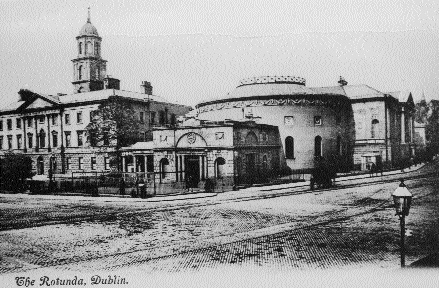
The Rotunda concert rooms, Dublin, where Balfe performed his first concert as a violin soloist at the age of nine in 1817.
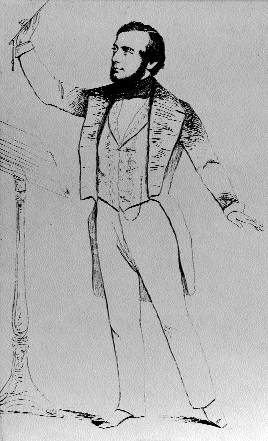
Drawing of a young Balfe in a conducting pose, Dublin, c. 1840s.
He countered with a promise to compose an opera for her one day, a promise he later kept. He also met the great soprano Giulia Grisi, another important figure who became a lifelong friend and who influenced a number of his future compositions.
London’s new composer
All of these experiences had matured Balfe considerably and had helped to develop his confidence and talents. As a result, he returned to London in May 1835 with good credentials. He was young (27); he was married and the father of a baby girl; he had composed three operas and a ballet while in Italy; he was a good singer and spoke Italian and French fluently. With Maria Malibran’s help, Balfe got the opportunity to compose an opera for Alfred Bunn, the lessee of the Theatre Royal, Drury Lane. Balfe quickly set to work and within two months had composed a new opera, The Siege of Rochelle. It premièred on 29 October 1835, and its phenomenal success set the stage for a relationship with London audiences that lasted 35 years.
Balfe afterwards wrote to Maria Malibran to thank her for helping him, saying that he would soon compose an opera for her and signing the letter ‘Billy Balfe the h’Irish potato h’eater’! The following year, the young musician made good on his promise by composing The Maid of Artois, which had its première on 27 May 1836 at Drury Lane. The presence of Malibran in Balfe’s new opera created a sensation and a great financial success. Sadly, four months later she was killed in a horse-riding accident at the age of 28 and at the peak of her career.
In 1838 four of the greatest Italian singers came to London to perform in a new work by Balfe, Falstaff (based on Shakespeare’s The Merry Wives of Windsor), which premièred on 19 July at Her Majesty’s Theatre with Luigi Lablache in the title role, and Giulia Grisi, Antonio Tamburini and Giovanni-Battista Rubini in the other principal roles. Balfe’s new opera was highly successful, with its arias, duets and trios, some of which Balfe later liked to sing at concerts. His Falstaff was greatly praised by the critics.
Dublin singing debut
In 1838 John W. Calcraft, manager of Dublin’s Theatre Royal, made Balfe an offer to sing in the winter English opera season commencing in November. Balfe’s long-time friend Richard M. Levey, who was the principal violinist in the theatre’s orchestra, probably influenced the decision. Levey was an important person in Dublin musical circles. Among other things he later became a founder of the Royal Irish Academy of Music, where his picture is displayed today. He and Balfe had been fellow music-students with teacher James Barton in the early days in Dublin.
Balfe returned to Dublin in November 1838 for the first time in fifteen years. He stayed at the fashionable Morrison’s Hotel at the corner of Dawson and Nassau Streets, an important meeting-place for the rich and famous throughout the century. Guests had included such greats as violinist Paganini, pianist Franz Liszt and soprano Giulia Grisi. Jenny Lind first arrived there in 1848, and the great Irish prima donna, Catherine Hayes, was a guest in 1849. At the height of the Land War Charles Stewart Parnell was arrested there in 1881. The hotel was demolished in 1899.
Upon his arrival, Balfe was scheduled to join the visiting English operatic troupe at the Theatre Royal. This would be his singing debut in Dublin and he went on to perform roles in Beethoven’s Fidelio (Rocco), Rossini’s Barber of Seville (Figaro), Cinderella (Dandini) and Bellini’s beautiful La Sonnambula (Rodolfo). It was the custom in those days in Dublin to offer entertainment above and beyond the advertised operatic work. This frequently included the principals singing arias and songs between the acts and after the opera.
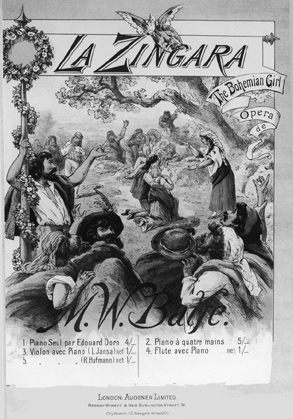
Sheet music cover (c. 1890s) for La Zingara, the Italian version of The Bohemian Girl.
The audience also liked to join in. Members of the audience in ‘the gods’ were famous for their vocal and verbal comments during and after performances. Balfe participated fully in this activity by singing on different occasions the wonderful buffo aria ‘Travellers All’ and ‘My Cottage near Rochelle’, both from his opera The Siege of Rochelle. He also sang two songs he had recently composed, ‘The Blighted Flower’ and ‘Il Postiglione’, and ‘The Light of Other Days’ from The Maid of Artois.
The ‘Irish Italian’ speaks
Early in December the Freeman’s Journal announced that a public dinner would be held in Morrison’s Hotel on the 28th to celebrate Balfe’s return. The evening was limited to a hundred gentlemen at a cost of one guinea each, a significant sum in those days. The function opened with a toast to the queen and the national anthem, with Balfe taking a leading part. He then rose to speak:
. . . I say my native city, for I believe that you are aware that I have the honour to be a Dublin man (cheers). I have travelled very far, and have brought out the first of my works in Italy. I was received with the greatest hospitality and encouragement and I am proud and happy to say that I have been most eminently successful. After going through a difficult ordeal I tried my fortune in London and never can forget the kind manner in which I was received there, although at first I was called a ‘foreigner’ or . . . an Irish Italian!
After so long an absence, if I have revisited my native city and the friends of my youth, I have done so on the liberal engagement of my friend, Mr Calcraft; and by the kind and liberal permission of the lessee of Drury Lane [Alfred Bunn], at a time when my absence was a great personal inconvenience to him. I need not tell you how delighted I have felt by the overwhelming kindness of the reception I have met with in the theatre [Royal] of Hawkins Street (cheers). It was indeed, a reception more than sufficiently complimentary to whatever talent I may possess. I feel that this is the proudest day of my life, and my most sanguine hope is that I may merit the honour, which you have bestowed on me. Gentlemen, I sincerely thank you all, and before I sit down permit me to express the wish that lies nearest to my heart, that I may soon have the pleasure of seeing you all again (loud continuous cheering).
Afterwards he sang the aria ‘When I Beheld the Anchor Weighed’ from The Siege of Rochelle, accompanying himself on the pianoforte. This was followed by other pieces and a lengthy duet from Falstaff, with Balfe taking the part of Falstaff and the baritone Antonio Sapio singing Ford’s part. Balfe concluded the festivities with his rollicking aria ‘Travellers All’.
Another year would pass before Balfe returned to his home town again, this time with his wife Lina Roser-Balfe. They initially performed in concert at the Theatre Royal, delighting the audience with a duet from Donizetti’s one-act comic opera Il Campanello. The two vocalists shared the platform with the famous young Swiss-born pianist and composer Sigismond Thalberg. Balfe and his wife then moved to the place of his early student days, the Rotunda concert rooms, to sing from the operas of Mozart, Rossini, Bellini, Donizetti and Balfe’s own Falstaff. They later returned to the Theatre Royal, where he performed in various operas, including the first performance in Ireland of The Maid of Artois. A number of years would pass before he returned to Ireland again, to introduce the famous soprano Jenny Lind to the audience at the Theatre Royal, where he conducted her performances. He returned on one other occasion to present his daughter Victoire, who had an excellent soprano voice, and to accompany her on a tour.
Back in London in 1841 he entered into theatre management, setting up an English opera company, which was backed by Queen Victoria. Unfortunately, the venture went bankrupt within six months and he vowed never again to become involved in that side of the business. Feeling dissatisfied, he then set off for Paris, where he performed in concerts and composed a new work, Le Puits d’Amour, which premièred at the Opéra Comique in April 1843 to considerable acclaim.
Success of The Bohemian Girl
However, 1843 held much greater promise for the talented Irish composer. On 27 November The Bohemian Girl premièred at Drury Lane and broke all records with a continuous run of over a hundred performances. Balfe was the talk of London.
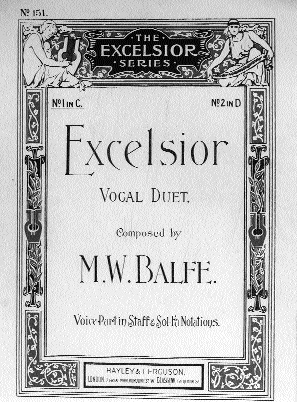
Sheet music cover for the duet ‘Excelsior’ (1857). Balfe composed around 250 songs, many of which became popular party pieces.
This opera, with its beautiful soprano aria ‘I Dreamt that I Dwelt in Marble Halls’ and the tenor aria ‘Then You’ll Remember Me’ (sometimes known as ‘When Other Lips’), and its wealth of other tuneful moments, became an instant success. During the first year more than 80,000 copies of the sheet music of the tenor aria were sold.
Within a year The Bohemian Girl was being performed in Dublin, New York and Philadelphia and other places in America. After that it swept around the globe. In a special German translation, Die Zigeunerin, it was produced and directed by Balfe in Vienna in 1846, and then in Hamburg, Berlin, Munich and Frankfurt. Australia first heard it in 1846, Stockholm in 1849. In Italy in 1854 it was performed as La Zingara in Trieste, Bologna, Bergamo, Verona and Brescia, with great appeal and a stellar cast. This Italian version was later produced in London, Dublin, New York and Boston.
In 1862 a French version, La Bohémienne, was performed in Rouen, with the young student composer Jules Massenet conducting. Later a revised version was heard in Paris. Toronto, Mexico City, Madrid and Capetown all heard it within a few years. Its popularity was truly amazing. By the end of the century The Bohemian Girl was perhaps the most performed opera anywhere. Occasionally it is still performed today in the English-speaking world.
Balfe’s career spanned almost 35 years. The success of The Bohemian Girl did not stop his output. During the next few years he commuted between Paris and London, composing new operas for each city with remarkable energy and success. In 1845 the Grand Opéra in Paris invited him to write a serious work for the theatre, which was then dominated by the composer Giacomo Meyerbeer. In December he produced L’Étoile de Séville with some of the best singers in Europe. It ran for fifteen nights and was deemed very successful. Unfortunately the autograph score cannot be found.
Balfe and Verdi
In 1846 Balfe became music director at Her Majesty’s Theatre, London, a position he held for six years. During that time he directed the local première of several of Verdi’s operas. He also conducted Jenny Lind’s debut and subsequent operatic performances. Verdi came to London for the first time in 1847 to conduct his new opera, I Masnadieri, featuring Jenny Lind. After two performances the Italian composer handed over his baton to Balfe, who finished the run. Balfe’s peers considered him an outstanding conductor. Balfe’s career continued to blossom as a composer both in Britain and on the Continent. He introduced several new operas over the next two decades, including The Rose of Castille, Satanella, The Puritan’s Daughter, The Armourer of Nantes, The Daughter of St Mark and others.
In 1850 Balfe conducted major concerts in London featuring most of the great singers of the time, including the renowned Limerick-born prima donna Catherine Hayes. He also wrote a song for her, ‘The Joy of Tears’, which she introduced at one of his concerts. In the following years he went to Berlin to direct one of his operas, and afterwards was invited to St Petersburg, Russia, where he spent time giving concerts. He later returned to Vienna and then on to Trieste and Paris to conduct operas. He also went back to Russia in 1860, bringing his daughter Victoire with him. He never visited America, although there was talk of him being made Director at the Academy of Music in New York in 1855, but nothing came of it.
His energy was boundless. Throughout all these years he also led an active social life, attending various functions involving royalty and special dinners. His erudite personality, quick wit and fluency in languages charmed people, while his great musical skills and gift for melody enchanted them.
Finale
In 1864, now aged 56, with somewhat failing health, Balfe decided to leave London and bought a property in rural Hertfordshire, where he spent his remaining days. His last opera, The Knight of the Leopard, based on a Sir Walter Scott novel, was not quite finished when he died at his home from complications of bronchial asthma and pneumonia in October 1870. His long-time friend, the conductor Michael Costs, completed the opera and had it translated into Italian for its première at Her Majesty’s Theatre as Il Talismano in June 1874. The critics felt it was one of his best works.
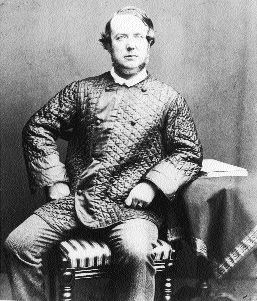
The mature Balfe, London, c. 1860
Balfe’s output, when one considers revisions, rewrites and foreign-language versions, probably amounted to about 40 operas in all. He also composed several cantatas, a symphony, and around 250 songs, of which the most famous are ‘Killarney’, ‘Come Into the Garden Maud’, ‘The Arrow and the Song’ and the duet ‘Excelsior’. He also completed new arrangements of Moore’s Melodies.
Remembering Balfe
Today, a large statue of Balfe stands on a pedestal in the entrance foyer to the Theatre Royal, Drury Lane, London, the place where he achieved so much success. It was the initiative of Balfe’s friend, the well-known Dublin-born playwright Dion Boucicault, and was erected in 1874. In October 1882 a marble tablet was erected in Westminster Abbey. In Dublin a bust of Balfe was placed in the National Gallery in July 1878, and a stained-glass window was unveiled in St Patrick’s Cathedral in April 1879. The house where Balfe was born in Dublin was demolished many years ago. A hotel was built on the spot. A plaque recognising Balfe’s birthplace is attached to the outside wall of the property. But of course the greatest monument to Balfe will always be his music. For most of his works the original autograph operatic scores are available in the British Library in London. They were donated by the composer’s widow just before she died in 1888. It was her intention that future generations should be able to listen to her husband’s music.
Basil Walsh is a Dublin-born author and writer on opera living in Delray Beach, Florida.
Further reading:
W.A. Barrett, Balfe, his life and work (London, 1882).
C.K. Kenney, Memoirs of Michael William Balfe (London, 1875).
B. Walsh, ‘Balfe in Italy’, in Opera Quarterly 18, no. 4 (Autumn 2002).
T.J. Walsh, Opera in Dublin 1798–1820 (New York, 1993).
















